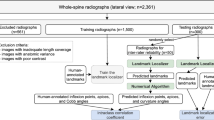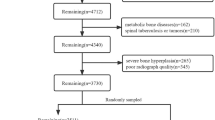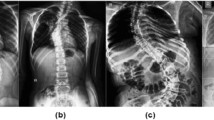Abstract
Analyzing spinal curvatures manually is time-consuming and tedious for clinicians, and intra-observer and inter-observer variability can affect manual measurements. In this study, we developed and evaluated the performance of an automated deep learning–based computer-aided diagnosis (CAD) tool for measuring the sagittal alignment of the spine from X-ray images. The CAD system proposed here performs two functions: deep learning–based lateral spine segmentation and automatic analysis of thoracic kyphosis and lumbar lordosis angles. We utilized 322 datasets with data augmentation for learning and fivefold cross-validation. The segmentation model was based on U-Net, which has multiple applications in medical image processing. Here, we utilized parameter equations and trigonometric functions to design spinal angle measurement algorithms. The kyphosis (T4–T12) and lordosis angle (L1–S1, L1–L5) were automatically measured to help diagnose kyphosis and lordosis. The segmentation model had precision, sensitivity, and dice similarity coefficient values of 90.53 ± 4.61%, 89.53 ± 1.8%, and 90.22 ± 0.62%, respectively. The performance of the CAD algorithm was also verified with the Pearson correlation, Bland–Altman, and intra-class correlation coefficient (ICC) analysis. The proposed angle measurement algorithm exhibited high similarity and reliability during verification. Therefore, CAD can help clinicians in reaching a diagnosis by analyzing the sagittal spinal curvatures while reducing observer-based variability and the required time or effort.











Similar content being viewed by others
Availability of Data and Material
Not applicable.
Code Availability
Not applicable.
References
R. Izzo, G. Guarnieri, G. Guglielmi, and M. Muto: Biomechanics of the spine. Part I: Spinal stability. Eur. J. Radiol., 82(1):118–126, 2013. https://doi.org/10.1016/j.ejrad.2012.07.024.
P. Roussouly and C. Nnadi: Sagittal plane deformity: an overview of interpretation and management. Eur. Spine J., 19(11):1824-1836, 2010. https://doi.org/10.1007/s00586-010-1476-9.
M. Dijkers: Quality of life after spinal cord injury: a meta analysis of the effects of disablement components. Spinal Cord, 35(12):829-840, 1997. https://doi.org/10.1038/sj.sc.3100571.
V. M. Ravindra et al.: Degenerative lumbar spine disease: estimating global incidence and worldwide volume. Glob. Spine J., 8(8):784–794, 2018. https://doi.org/10.1177/2192568218770769.
E. K. Wai et al.: Quality of life in surgical treatment of metastatic spine disease. Spine (Phila. Pa. 1976)., 28(5):508–512, 2003. https://doi.org/10.1097/01.BRS.0000048646.26222.FA.
F. Schwab et al.: Adult scoliosis: prevalence, SF-36, and nutritional parameters in an elderly volunteer population. Spine (Phila. Pa. 1976).,30(9):1082–1085, 2005. https://doi.org/10.1097/01.brs.0000160842.43482.cd.
F. Schwab et al.: Scoliosis Research Society-Schwab adult spinal deformity classification: a validation study. Spine (Phila. Pa. 1976).37(12):1077–1082, 2012. https://doi.org/10.1097/BRS.0b013e31823e15e2.
M. S. Harreby et al.: Risk factors for low back pain in a cohort of 1389 Danish school children: an epidemiological study. Ugeskr. Laeger, 163(3):282–286, 2001.
B. Skoffer and A. Foldspang: Physical activity and low-back pain in schoolchildren. Eur. Spine J., 17(3):373–379, 2008. https://doi.org/10.1007/s00586-007-0583-8.
W. M. Balagué F, Dutoit G: Low back pain in schoolchildren. An epidemiological study. Scand. J. Rehabil. Med., 20(4):175–179, 1988.
E. Barrett, K. McCreesh, and J. Lewis: Intrarater and interrater reliability of the flexicurve index, flexicurve angle, and manual inclinometer for the measurement of thoracic kyphosis. Rehabil. Res. Pract., 2013:1–7, 2013. https://doi.org/10.1155/2013/475870.
B. P. Harrison, Deed E. DC, Cailliet et al.: Reliability of Centroid, Cobb, and Harrison posterior tangent methods. Spine (Phila. Pa. 1976)., 26(11):e227–e234, 2001.
A. M. Briggs, T. V. Wrigley, E. A. Tully, P. E. Adams, A. M. Greig, and K. L. Bennell: Radiographic measures of thoracic kyphosis in osteoporosis: Cobb and vertebral centroid angles. Skeletal Radiol., 36(8):761–767, 2007.
R. T. Morrissy, G. S. Goldsmith, E. C. Hall, D. Kehl, and G. H. Cowie: Measurement of the Cobb angle on radiographs of patients who have scoliosis. Evaluation of intrinsic error. J. bone Jt. Surg., 72:320–327, 2008.
N. R. Dang, M. J. Moreau, D. L. Hill, J. K. Mahood, and J. Raso: Intra-observer reproducibility and interobserver reliability of the radiographic parameters in the spinal deformity study group’s AIS Radiographic Measurement Manual. Spine (Phila. Pa. 1976)., 30(9):1064–1069, 2005. https://doi.org/10.1097/01.brs.0000160840.51621.6b.
[16]R. S. Alomari, V. Chaudhary, and G. Dhillon: Computer aided diagnosis system for lumbar spine. ACM Int. Conf. Proceeding Ser., 2011. https://doi.org/10.1145/2093698.2093843.
K. Alawneh, M. Al-Dwiekat, M. Alsmirat, and M. Al-Ayyoub: Computer-aided diagnosis of lumbar disc herniation. 2015 6th Int. Conf. Inf. Commun. Syst. ICICS 2015, no. April, pp. 286–291, 2015. https://doi.org/10.1109/IACS.2015.7103190.
Barron, Valerie: Generation of a finite element model of the thoracolumbar spine. Acta of Bioengineering and Biomechanics, 9(1):35–46, 2007.
M. Tiouririne, A. J. Dixon, F. W. Mauldin, D. Scalzo, and A. Krishnaraj: Imaging performance of a handheld ultrasound system with real-time computer-aided detection of lumbar spine anatomy: a feasibility study. Invest. Radiol., 52(8):447–455, 2017. https://doi.org/10.1097/RLI.0000000000000361.
S. R. O’Connor SD, Yao JH: Lytic metastases in thoracolumbar spine: computer-aided detection at CT—preliminary study. Radiology, 242(3):811–816, 2007.
S. M. M. R. Al Arif, K. Knapp, and G. Slabaugh: Fully automatic cervical vertebrae segmentation framework for X-ray images. Comput. Methods Programs Biomed., 157:95–111, 2018. https://doi.org/10.1016/j.cmpb.2018.01.006.
Y. J. Kim, B. Ganbold, and K. G. Kim: Web-based spine segmentation using deep learning in computed tomography images. Healthc. Inform. Res., vol. 26, no. 1, pp. 61–67, 2020. https://doi.org/10.4258/hir.2020.26.1.61.
Y. Liu, X. Sui, C. Liu, X. Kuang, and Y. Hu: Automatic lumbar spine tracking based on Siamese convolutional network. J. Digit. Imaging, 33(2):423–430, 2020. https://doi.org/10.1007/s10278-019-00273-5.
D. Zhang, B. Chen, and S. Li: Sequential conditional reinforcement learning for simultaneous vertebral body detection and segmentation with modeling the spine anatomy. Med. Image Anal., 67:101861, 2021. https://doi.org/10.1016/j.media.2020.101861.
B. Samuvel, V. Thomas, M. G. Mini, and J. Renjith Kumar: A mask based segmentation algorithm for automatic measurement of Cobb angle from scoliosis x-ray image. Proc. - 2012 Int. Conf. Adv. Comput. Commun. ICACC 2012, pp. 110–113, 2012. https://doi.org/10.1109/ICACC.2012.24.
M. H. Horng, C. P. Kuok, M. J. Fu, C. J. Lin, and Y. N. Sun: Cobb angle measurement of spine from x-ray images using convolutional neural network. Comput. Math. Methods Med., 2019, 2019. https://doi.org/10.1155/2019/6357171.
R. H. Alharbi, M. B. Alshaye, M. M. Alkanhal, N. M. Alharbi, M. A. Alzahrani, and O. A. Alrehaili: Deep learning based algorithm for automatic scoliosis angle measurement. ICCAIS 2020 - 3rd Int. Conf. Comput. Appl. Inf. Secur., pp. 1–5, 2020. https://doi.org/10.1109/ICCAIS48893.2020.9096753.
T. Long, J., Shelhamer, E. & Darrell: Fully convolutional networks for semantic segmentation. IEEE Conf. Comput. Vis. Pattern Recognit.(CVPR) 3431–3440 (IEEE, Piscataway, NJ, USA, 2015).
M. Mccormick, X. Liu, J. Jomier, C. Marion, and L. Ibanez: Itk: Enabling reproducible research and open science. Front. Neuroinform., 8(FEB):1–11, 2014. https://doi.org/10.3389/fninf.2014.00013.
B. Schroeder, Will: Martin, Ken: The Visualization Toolkit, 4th ed, Lorensen: Kitware, 2006, ISBN 978–1–930934–19–1.
S. Noguchi, M. Nishio, M. Yakami, K. Nakagomi, and K. Togashi: Bone segmentation on whole-body CT using convolutional neural network with novel data augmentation techniques. Comput. Biol. Med., 121(January):103767, 2020. https://doi.org/10.1016/j.compbiomed.2020.103767.
S. Kim: End-to-end bone tumor segmentation and classification from X-ray images by using multi-level Seg-Unet model. Journal of KIISE, 47(2):170–179, 2020.
K. Murata et al.: Spinal sagittal alignment in patients with dropped head syndrome. Spine (Phila. Pa. 1976)., 43(21):E1267–E1273, 2018. https://doi.org/10.1097/BRS.0000000000002685.
Stagnara P, De Mauroy JC, Dran G, Gonon GP, et al.: Reciprocal angulation of vertebral bodies in a sagittal plane: approach to references for the evaluation of kyphosis and lordosis. Spine. 7(4):335-342, 1982.
R. Vialle, N. Levassor, L. Rillardon: Radiographic analysis of the sagittal alignment and balance of the spine in asymptomatic subjects. The Journal of Bone & Joint Surgery, 87(2):260–267, 2005. https://doi.org/10.2106/00004623-200502000-00004.
N. J. Gogtay and U. M. Thatte: Principles of correlation analysis. Journal of The Association of Physicians of India, 65:78–81, 2017.
Cicchetti, Domenic V: Guidelines, criteria, and rules of thumb for evaluating normed and standardized assessment instruments in psychology. Psychological assessment, 6(4):284–290, 1994. https://doi.org/10.1037/1040-3590.6.4.284.
J. R. Taylor: Growth of human intervertebral discs and vertebral bodies. J. Anat., 120(Pt 1):49–68, 1975.
M. Gstoettner, K. Sekyra, N. Walochnik: Inter- and intraobserver reliability assessment of the Cobb angle: manual versus digital measurement tools. Eur. Spine J., 16(10):1587–1592, 2007. https://doi.org/10.1007/s00586-007-0401-3.
Amanda C.Y.Chan; Devlin G.Morrison: Intra- and interobserver reliability of the Cobb angle–vertebral rotation angle–spinous process angle for adolescent idiopathic scoliosis. Spine Deform., 2(3):168–175, 2014. https://doi.org/10.1016/j.jspd.2014.02.006.
J. G. Carman, D L; Browne, R H; Birch: Measurement of scoliosis and kyphosis radiographs. Intraobserver and interobserver variation. J. Bone Jt. Surg., 72(3):328–333, 1990.
Funding
This work was supported by the National Research Foundation of Korea (NRF) grant funded by the Korea government (MSIT) (No. NRF-2019R1G1A1100487), and by the MSIT (Ministry of Science and ICT), Korea, under the ITRC (Information Technology Research Center) support program (IITP-2021–2017-0–01630) supervised by the IITP (Institute for Information & communications Technology Promotion), and by the GRRC program of Gyeonggi province. [GRRC-Gachon2020(B01), AI-based Medical Image Analysis.
Author information
Authors and Affiliations
Contributions
Kwang Gi Kim and Ji Young Jeon contributed equally in this work.
Corresponding authors
Ethics declarations
Ethics Approval
All procedures performed in studies involving human participants were in accordance with the ethical standards of the institutional and/or national research committee and with the 1964 Helsinki Declaration and its later amendments or comparable ethical standards. The study was approved by the institutional review board of Gachon University Gil Hospital (IRB number: GDIRB2019-137).
Consent to Participate
Informed consent was obtained from all individual participants included in the study.
Consent for Publication
Patients signed informed consent regarding publishing their data and photographs.
Conflict of Interest
The authors declare no competing interests.
Additional information
Publisher's Note
Springer Nature remains neutral with regard to jurisdictional claims in published maps and institutional affiliations.
Rights and permissions
About this article
Cite this article
Lee, H.M., Kim, Y.J., Cho, J.B. et al. Computer-Aided Diagnosis for Determining Sagittal Spinal Curvatures Using Deep Learning and Radiography. J Digit Imaging 35, 846–859 (2022). https://doi.org/10.1007/s10278-022-00592-0
Received:
Revised:
Accepted:
Published:
Issue Date:
DOI: https://doi.org/10.1007/s10278-022-00592-0




